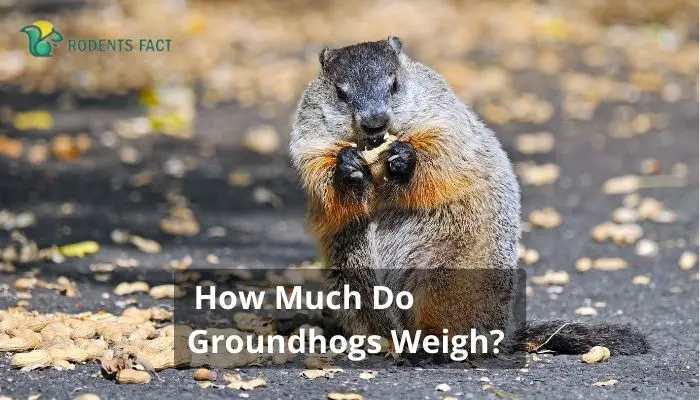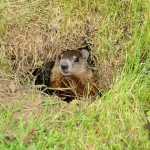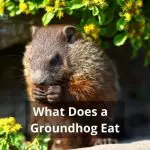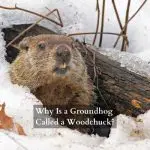How Much Do Groundhogs Weigh? | Facts on Size, Weight, and Diet
Groundhogs like to live on the fringes of forests, meadows, open fields, highways, and streams. Also, you may see them in wooded areas rather often.
Although groundhogs are known for their enormous burrow networks and impressive digging abilities, these animals are also strong swimmers and adept tree climbers. A groundhog’s body is thick and stocky, and its legs are short.

But How Much Do Groundhogs Weigh?
The typical groundhog weighs 5-10 pounds and is 16-20 inches long. Tail lengths range from around 4 to 7 inches. Tail included, this creature is wholly furred from head to toe. Male and female groundhogs seem pretty similar, with the possible exception that males tend to be bigger.
Groundhog Weights
Although most groundhogs are a shade of grey-brown, there are also black and albino varieties. Most of their time is spent underground in their burrows, although they go out briefly each day, in the morning and evening, to seek food.

Their long, curved claws come in handy while digging out their underground lairs. The incisor teeth of groundhogs, like other rodents, are rather long.
The American festival called Groundhog Day is celebrated annually on February 2 because of the widespread belief that groundhog behavior predicts the next change of seasons.
The ability of a groundhog to see its shadow is the highlight of this yearly festival when it is treated as a star attraction.
At the first hint of winter, a groundhog will go to its subterranean burrow to hibernate until spring (usually the first frost). This time of dormancy might last anywhere from three to six months, depending on where in the world you live. The groundhog relies on its stored fat from the previous year for sustenance during this period.
Generally speaking, a baby groundhog is considered to be under 10 inches in length. After birth, they will continue to shrink. Any groundhog with a body length of fewer than 10 inches is still a juvenile and needs special care until it reaches adulthood.

If it is indeed a newborn groundhog, it will not be much bigger than a matchbox. Baby weight is another method for determining whether or not the child is an infant.
Groundhog puppies weigh barely a few ounces at birth. They have no hair, can not see or hear, and are totally helpless. The puppies mature quickly and are ready for weaning after just five weeks.
A woodchuck weighing just 25–30 grams would be considered a baby. On the other hand, some fully grown groundhogs might weigh far less than others. It is almost certainly a young groundhog if the weight is under 30 grams.
Additional Read: Do you ever wonder why Beavers have red teeth?

Groundhog Diet and How it Contributes to Their Weight
Hog-nosed rodents do not eat meat. Grass, other green plants, certain fruits, and tree bark and bud are also part of their diet. They store up a ton of fat over the summer and early autumn before hibernating for the winter.

In the summer, a groundhog may eat more than a pound of foliage at once, according to the NWF. Imagine a guy who weighs 150 pounds devouring a 15-pound steak.
The approach of spring is not the only thing groundhogs can predict. Due to their voracious appetites, groundhogs (sometimes called woodchucks) may wreak havoc on human and animal property.
Groundhogs sometimes do weird things. The easiest way to respond to this issue is to study the kinds of meals and eating routines that are most popular among them.
Types of Food
Bush leaves, nuts, grains, ferns, wildflowers, grass, and fruits are all staples in the groundhog’s diet. Chickweed, clover, plantains, asters, dandelion, and sorrel are just a few plants favored by this species as food.

They value luscious vegetation highly. Cherries and blackberries are two of their favorite fruits. Peas, beans, lettuce, squash, broccoli, maize, and soybeans are some cultivated crops they like munching on, which may make them a nuisance to people.
Groundhogs may consume almost a pound of vegetation every day once they reach adulthood.
The diet of a groundhog does not consist only of plants.

While groundhogs mostly consume plant matter for sustenance, they may sometimes snack on insects, snails, baby birds, and even eggs. Larger insects like June bugs and grasshoppers tend to attract them.
It contributes a lot of protein and fat to their diet. Thus it increases their size as well as their weight.
Detailed Food List: what does a groundhog eat
Precisely what kind of food and drink do groundhogs prefer? Herbivorous groundhogs depend on standard garden fare, although they also like the occasional bug or worm.
The smell of these meals may entice groundhogs. Therefore, groundhog food in your garden increases the likelihood that groundhogs may dig burrows close to your house. This is remarkably accurate given that groundhogs seldom go more than a hundred and fifty feet from their burrows in search of food.

Groundhogs may cause damage to your garden by eating your harvests or cutting your plants at an angle. Since groundhogs can eradicate whole plant communities, an abundance of weeds in certain places may point to groundhogs living on your land.
Getting in touch with a pest management expert as soon as possible is recommended if you fear a groundhog is destroying your garden.
Seasonal Eating Patterns
The groundhog is mainly a vegetarian, meaning it eats plant-based foods, including greens, fruits, and veggies but may sometimes augment its diet with insects. As a result of their ravenous hunger, they may easily destroy an entire crop in a single night.

The diet of a groundhog is very specialized, and it changes with the seasons. The groundhog has its midday meal in the spring and autumn.
During the summer, you may see them rummaging in gardens early in the morning and again in the late afternoon. However, what do groundhogs consume in the colder months?
Indeed, they don’t. Instead, they use the time between October and February to bulk up for the hibernation ahead. They hide away in their subterranean tunnels during the winter.
By February, groundhogs have dropped half their weight from hibernation and are ready to resume eating.
How is Hibernation Related to Groundhog Weight?
During the summer and early autumn, groundhogs consume a lot of food to build up large fat stores before going into hibernation for the winter. During the warm season, the NWF reports that a groundhog may consume more than a pound of foliage in a single sitting.
This is true even while the groundhog is feeding. This is like a guy weighing 150 pounds devouring a 15-pound meal in one sitting.

Because it prepares its body for hibernation by storing fat during the autumn, a groundhog will have gained weight by winter.
In the spring, its body will have burned off a significant amount of the stored fat, resulting in a weight reduction.

Exactly like groundhogs, do guinea pigs go into hibernation? If they do, then there is no need for alarm. The following are some more details regarding guinea pigs in hibernation.
Frequently Asked Questions
1. What Is the Life Expectancy of a Groundhog?
The usual lifespan of a wild groundhog, sometimes termed a woodchuck, is between four and five years. However, these animals may live as long as six years. They have been known to survive for ten years or more when kept in captivity.
However, they spend the better part of their lives sleeping in a condition similar to a coma and do not wake up even when touched.
2. Do People Eat Groundhogs?
Not only can you eat groundhogs, but if you properly clean and cook them, they also have a soft texture and a great flavor. They consume nothing that is not plant-based in their diet and do not transmit any illnesses that are fatal to people.
The flavor of groundhogs is comparable to that of rabbits, and most groundhog recipes instruct you to cook the meat the same way as you would rabbit.
3. What Purpose Do Groundhogs Serve?
Groundhogs contribute to the aeration of the soil by their digging behavior. Just like every other part of the plant, roots are required to respire, which means they must take in oxygen and release carbon dioxide.
When roots are left in unturned dirt, they use up what little oxygen they have while carbon dioxide builds up, making it difficult for the roots to “breathe.”
4. What Time of Day Are Groundhogs Most Active?
From spring through autumn, groundhogs are diurnal, meaning they are active throughout the day. The groundhogs come out of their holes in the morning and later in the evening to forage for food. Thus these are the times when there is the most activity.
Final Words
That is all there is to know about “how much do groundhogs weigh?”. Although they spend most of their time below, groundhogs will attack crops by dragging roots like carrots and tubers down into their burrows.
When threatened, groundhogs will immediately retreat to their burrow. If confronted, however, they will not hesitate to use their enormous incisors and keen claws to defend themselves.
Despite their small size (approximately 10 pounds) and 20 inches in length, groundhogs have been known to fend off bobcats, coyotes, and even some household dogs. However, most predators in North America, especially foxes, rely on them as a primary source of food.




